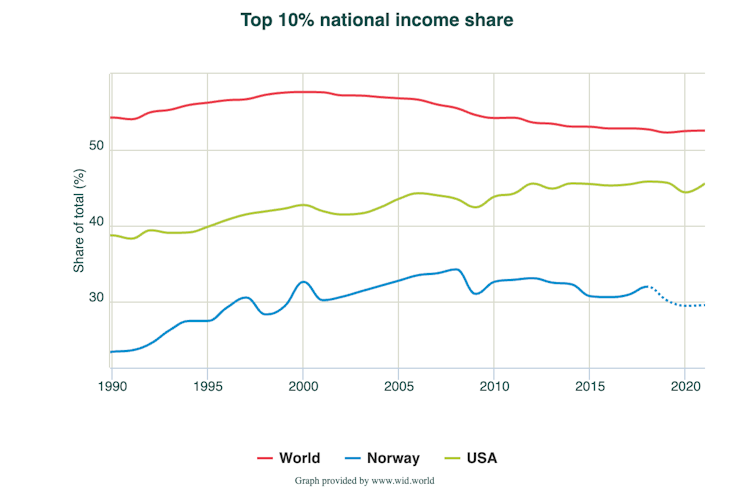Global Inequality Must Fall to Maintain a Safe Climate and Achieve a Decent Standard of Living For All – It’s a Huge Challenge

Joel Millward-Hopkins and Yannick Oswald
Energy consumption is essential for human wellbeing, but there is enormous inequality in energy use worldwide. The top 10% of global energy consumers use roughly 30 times more energy than the bottom 10%.
Our energy use also drives climate change. So to maintain a safe climate, we may have to use less energy in the future. Achieving this while ensuring that everyone enjoys a decent standard of living may require drastic reductions in global energy inequality.
In a recent study, we modelled how much energy inequality would have to reduce to secure human wellbeing and climate safety. We found that the gap in energy consumption between the world’s lowest and highest energy consumers would have to reduce eight-fold by 2050.
But if current energy inequalities remain, more than 4 billion people in the global south and over 100 million in the global north will be unable to enjoy a decent standard of living by 2050. The global south refers to countries in Asia, Africa and Latin America while the global north consists of countries typically thought of as the “developed” western world, with the inclusion of richer Asian countries such as Japan, South Korea and Singapore.

Kingj123/Gendered Lives, CC BY-NC-ND
Low energy, decent living
Most climate scenarios that limit global warming to safe levels do not assume that energy consumption will reduce. They instead rely on the use of negative emissions technologies such as biomass combustion with carbon capture or direct air capture.
But these technologies are unproven at scale and could conflict with wildlife and food production. Research suggests that large-scale bioenergy production could substantially increase rates of deforestation and food prices.
Climate scientists have responded by exploring other scenarios to reduce energy demand.
The most prominent is the global low energy demand scenario. This scenario suggests a 40% reduction in energy use can be achieved by 2050 through several structural changes to energy systems. These include energy efficiency improvements coupled with reducing travel or using fewer carbon intensive materials like steel. In this case, living standards would be raised in the global south and maintained in the global north.
Based on theories of human needs, other research measures “decent living energy”. This is the minimum energy required for the material conditions needed to provide decent living standards.
The amount of energy needed to provide these things is then calculated using data on the efficiency of available technologies. Research that we co-authored in 2020 estimates decent living energy to be about 15 gigajoules annually for each person. This is just one-tenth of the average American’s annual energy consumption.
Good news – with a catch
We combined these two lines of research with data on global energy inequality to explore the issues crucial to sustainable development.
Low energy demand research suggests that a sustainable level of global energy demand is well above the 15 gigajoules each person requires. This is good news but it does not guarantee everyone access to decent living energy. After all, enough food is produced to feed the world’s population, yet people still go hungry.
Average numbers for energy use do not apply to all people. If energy inequality remains and global energy demand follows the low energy demand scenario, then billions of people would remain below the energy threshold required for a decent standard of living.
But the decent living energy threshold is a hard constraint that no one should fall below. Given this constraint and the need for a safe climate, energy inequality must fall – and do so drastically.
Unprecedented change
The size of this challenge becomes clear when we consider the close relationship between energy and income inequality. For example, the top 1% of the world’s population has been responsible for 23% of global emissions since 1990. So to reduce global energy inequality by the amount we suggest is required will demand that income inequality falls to levels currently seen in more equal European countries such as Norway, with its generous welfare system.

World Inequality Database, CC BY-NC-ND
The rate at which income inequality would need to reduce to maintain decent living standards in a safe climate would exceed rates seen in the so-called “golden age of capitalism”, after the second world war. During this period (1950–1975), the share of income captured by the top 1% of earners in the US fell from 17% to 10%. But changes to income inequality that are caused by major economic shocks can be unpredictable and uncontrollable.
On average, the level of global income inequality seen during the past 150 years of capitalism has remained persistently high. Inequality has slightly reduced between countries, but inequality within them has grown. Income in fast-growing countries such as China is catching up with western Europe. But income inequality, particularly in wealthy countries, has widened. In 2021, the top 10% of earners in the USA received 45.6% of national income, compared to 33.5% in 1970.
This leaves us sceptical that climate collapse can be prevented and social deprivation can be reduced without transforming the economic system. But we can’t rule it out.
Perhaps the economy will change in a way that allows the world’s rich to remain so but also use less energy. This would make room for low energy consumers to increase their consumption. The world’s energy supply may also be increased more sustainably in the future, allowing consumption at the bottom to rise despite persisting energy inequality.
Or perhaps the reductions in inequality that may be needed will be achieved through economic transformation towards a system that doesn’t need to keep growing unsustainably as a way of mitigating against inequality.
Whatever the answer, business as usual won’t do.
This article is republished from The Conversation under a Creative Commons license. Read the original article.
